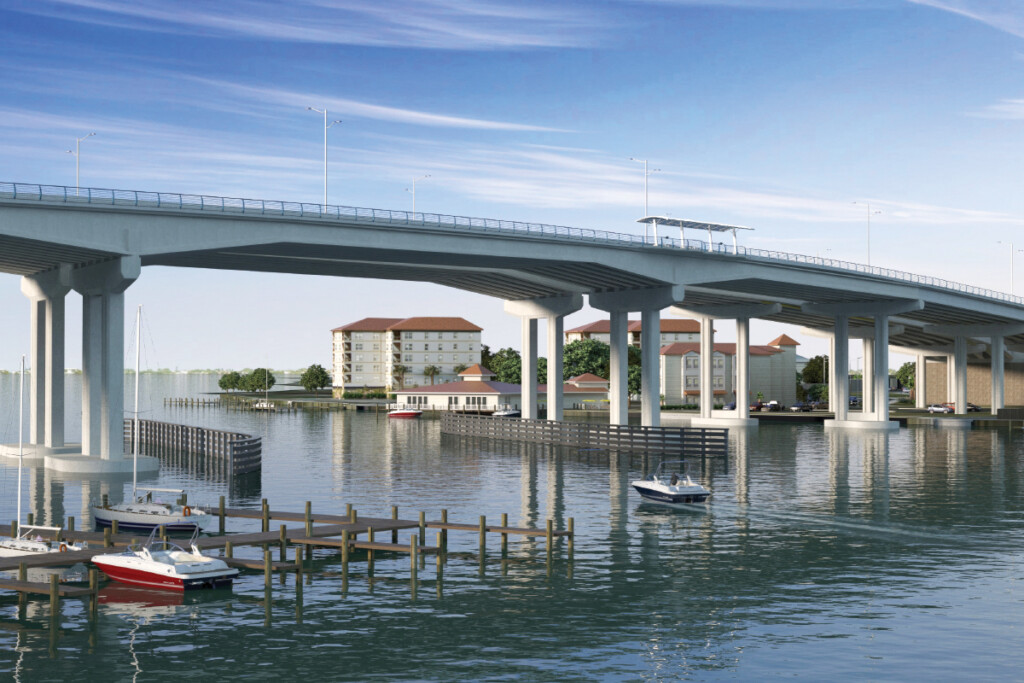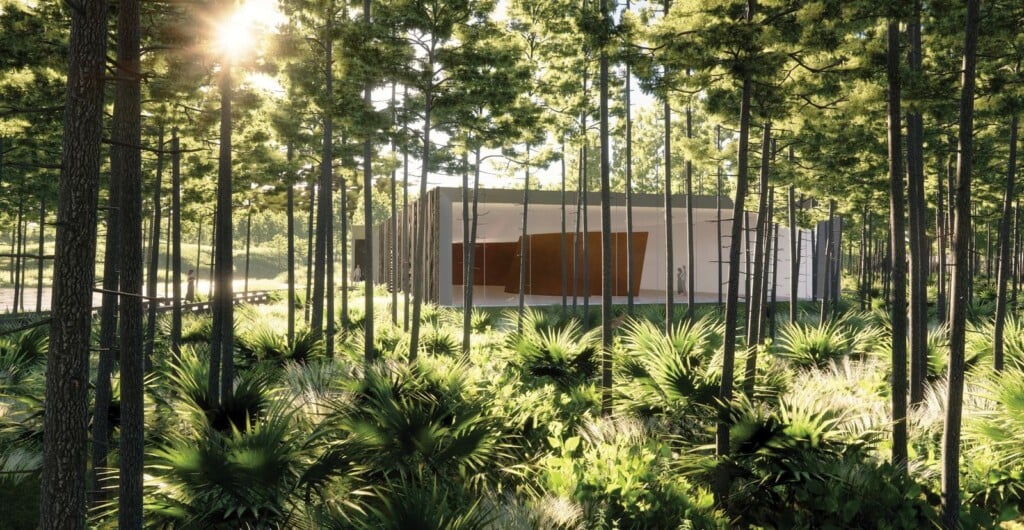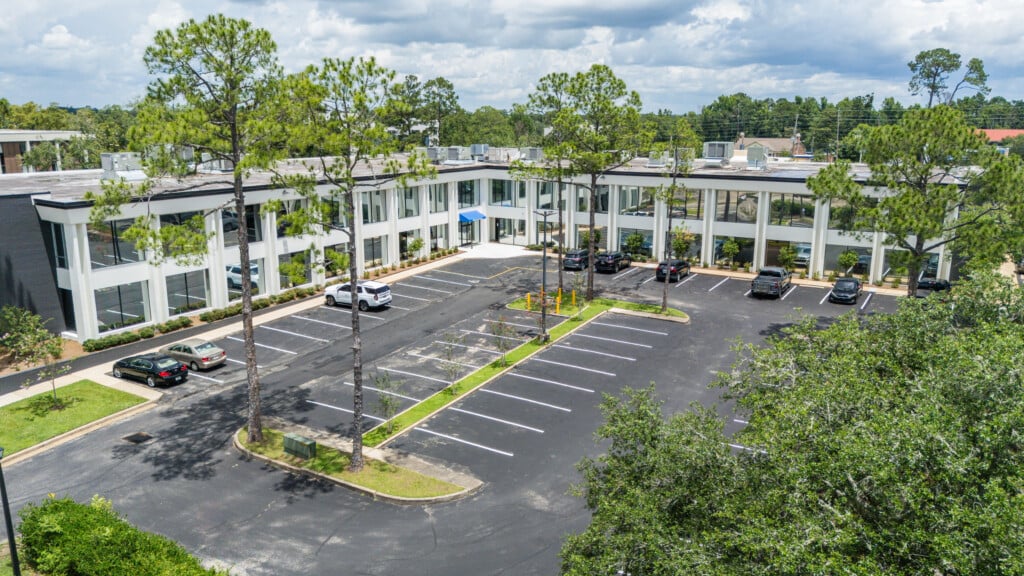Growing Pains
Over the Brooks Bridge and Around the Mound, Fort Walton Beach experiences an era of change

For decades, Emerald Coast locals have been battling tourism-congested commutes up and down Highway 98. In Fort Walton Beach, a convergence of local and transient travelers has created a bottleneck at the Brooks Bridge.
A new bridge, planned for completion in 2027, is set to solve some of these problems, but the interim has created additional traffic obstacles. Greater Fort Walton Beach Chamber of Commerce president and CEO Ted Corcoran says the benefits far outweigh the growing pains.
“We’ve got to do it; you can’t complain,” he says. “Time will pass, and we’ll say, ‘Oh my gosh, this is wonderful. I don’t even remember being inconvenienced.’”
In 1966, the Brooks Bridge experienced its first dramatic upgrade from two lanes to four, from wood to concrete, and from flat to curved. It was built with a 50-year life expectancy, but already after a decade, Corcoran says, traffic had increased from around 2,000 cars a day to upwards of 15,000 cars a day.
In 2005, local historian and business owner Tom Rice led the Emerald Coast Bridge Authority in brainstorming a solution.
“The capacity was terrible—there were too many cars for too little space,” Rice says. “But the DOT doesn’t give you any money for capacity.”
Without funding, Rice’s bridge proposal would have to include a toll facility. With a lack of consensus and money, plans fell to the wayside. Today’s bridge project, he says, is being funded due to age.
“This will be the third bridge in my lifetime,” says Rice, who can recall the original 1933-built Brooks Bridge. “It was a trestle. And the trestle moved when the boats would come down the sound. You’d hear the bell ringing if you rode your bicycle down there on main street, at the grocery store, or at Roberts Rexall Drugs.”
Today, the heavily traveled segment of Highway 98 experiences 66,000 drivers daily, according to the Florida Department of Transportation (FDOT).
The new Brooks Bridge,
a $171 million project, will expand to six lanes with the addition of a 12-foot-wide pedestrian and bicyclist path in each direction. The paths will feature a safety barrier wall and scenic overlooks with shade structures.
The new bridge will extend past Okaloosa Island’s current Highway 98 and Santa Rosa Boulevard intersection. While drivers coming from Fort Walton Beach and headed to Santa Rosa Boulevard’s strip of condominiums and beach accesses will now exit the bridge at Pier Road, travelers driving from Destin to Santa Rosa Boulevard will exit after the Destin-Fort Walton Beach convention center then loop around the bayside corner.
“It will revolutionize Okaloosa Island,” Corcoran says, noting that this will increase visibility for businesses on the north side of the island.
But how long will these improvements accommodate our growth? According to FDOT, Florida’s population is projected to increase by 1,000 people daily for the next 30 years. In 2024, tourism numbers broke records with 142.9 million visitors to the Sunshine State.
Research for the new bridge began in 2016. Those numbers are already nearly a decade old.
“It probably already is surpassing the capacity of that,” Corcoran says. “It will be interesting to see what happens in 50 years, how many more people will be coming here.”
A piggyback project, Around the Mound in downtown Fort Walton Beach, plans to help alleviate the bottlenecking, potentially diverting Highway 98 traffic around the Indian Temple Mound Museum, separating downtown from the flow of highway traffic.
“Right now, if there’s no Around the Mound, it doesn’t change downtown,” says Corcoran, who sees the project as downtown’s route to revolution. “Now, downtown becomes that strolling marketplace. Now, you’re driving down there to park and walk around downtown, like you walk around any cool downtown space.”
Rice says the redesign of downtown is a return to the old ways.
Rice is skeptical that “somehow all this property that’s south of that Around the Mound will blossom into something akin to what I grew up with, with Robert’s Rexall Drugs and Miss Eloise’s store. Somehow, this is going to be some kind of magic? I don’t know,” Rice says. “I haven’t been convinced by the arguments that it’s going to help transportation.”
An alternative meeting in February 2024 offered conceptualization of two options, one at grade and one elevated with bridges. Project cost estimations range from $299 million to $312 million and would require one residential relocation and between 69-71 business relocations. A final public hearing will be held before finalizing the PDE phase and moving onto design.
Already, $40.5 million has been invested in the project development and environment (PDE) study phase for Around the Mound.
Will a return to Old Florida be worth the cost?
“If we want Fort Walton Beach to have a downtown and to turn into a destination and not just a drive-thru, then absolutely I think it’s worth it,” Corcoran says. “I think it will be one of the most dramatic changes ever to Fort Walton Beach.”
A loss of some 70 businesses sounds like a heavy blow. But Corcoran says most business owners wouldn’t mind the eminent domain payout. If the business is viable, they’ll have the funding to move elsewhere in town.
Rice’s business once benefited from an eminent domain buyout. When Publix arrived at the Paradise Point Shopping Center across the street, Magnolia Grill got the boot. The funding helped him purchase and renovate the historic home where Magnolia Grill lives today.
He admits, “Sometimes change can be really good.” ▪


